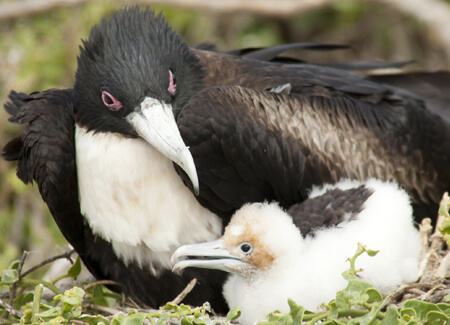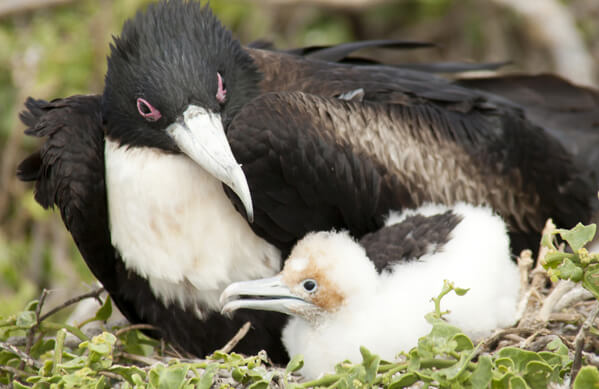 The Great Frigatebird has a distinctive flight silhouette, with long, pointed wings and a deeply forked tail. Like the Swallow-tailed Kite, its wings allow for graceful aerial acrobatics and effortless soaring. Frigatebirds often use their aerial agility to harass other birds into dropping their prey, earning this pirate of tropical skies the nickname of “Man-o'-War Bird.” The Hawaiian word for frigatebird is ‘Iwa, meaning “thief.”
The Great Frigatebird has a distinctive flight silhouette, with long, pointed wings and a deeply forked tail. Like the Swallow-tailed Kite, its wings allow for graceful aerial acrobatics and effortless soaring. Frigatebirds often use their aerial agility to harass other birds into dropping their prey, earning this pirate of tropical skies the nickname of “Man-o'-War Bird.” The Hawaiian word for frigatebird is ‘Iwa, meaning “thief.”
In past days, the bird's tapering, iridescent feathers were collected and used by Polynesians to create cloaks and feathered staffs for their elite.
Aerial Experts
Like California Condor and other raptors, Great Frigatebirds use thermals to soar and glide for hours. Frigatebirds may even sleep on the wing!
Their flight pattern is unique: The birds soar upward in circles on thermals in a series of climbs and descents, rising to heights of 8,000 feet or more before gliding down in the direction of travel. This flight pattern allows the bird to cover long distances with minimal energetic cost—an advantage when food is scarce over the ocean.
Although the Great Frigatebird spends most of its life on the wing, it rarely, if ever, alights on the water. Its plumage is not waterproof and weighs the bird down if soaked. If a frigatebird accidentally takes a plunge, it must dry in the sun with wings fully extended before it can fly again.
Sign up for ABC's eNews to learn how you can help protect birds
Fighting for Food
The technical term for the Frigatebird's pirate-like behavior is “kleptoparasitism.” Despite its bad reputation, the Great Frigatebird actually catches most of its food itself, skimming flying fish, squid, jellyfish, and turtles from the water's surface.
At sea, the birds forage alone or in pairs, but will gather in larger groups when marine predators such as dolphins or tuna drive prey to the surface. Frigatebirds also follow fishing boats and haunt ports for scraps and offal discarded by humans, and they frequently eat the eggs and young of other seabirds, particularly terns.
Long-term Parenting
Including Great Frigatebird, there are five frigatebird species, and all are sexually dimorphic, with males and females having different plumage. The sexes also differ in size, with females growing larger and heavier than males. Frigatebirds nest in large colonies, often in very close proximity.
Like its close relative, the Magnificent Frigatebird, Great Frigatebird males are well-known for their red throat sacs, which they inflate like red balloons to attract females during courtship. Males display in groups with these “gular” sacs inflated, bills clattering and heads and wings waving, while calling to females flying overhead.
Once a female chooses a mate, she begins to build a platform nest of sticks and twigs on the flat top of a low bush or tree. The male assists in nest-building by bringing materials. Both sexes take turns incubating the single egg.

Great Frigatebird by MindStorm, Shutterstock
The parent frigatebirds demonstrate exceptional dedication, caring for the chick until it fledges at up to four months and feeding the fledgling for several more months as the young bird learns survival skills. This extended period of parental care is the longest of all birds and means that a female can only breed in alternate years.
Despite this concentrated level of care, many chicks starve to death within months of becoming fully independent. The species' low productivity rates, coupled with late sexual maturity (birds may not breed until 8 to 10 years old) make frigatebirds especially vulnerable to disruptions at their breeding colonies.
Threat-proofing Populations
Other threats to Great Frigatebirds include habitat loss and introduced predators, such as cats, on nesting islands. Overfishing and climate change may also pose problems.
However, good-sized populations of Great Frigatebird can be found on Laysan Island, where ABC and partners successfully established a second population of the endangered Millerbird. Great Frigatebirds can also be spotted roosting at Kilauea Point National Wildlife Refuge on Kauai, along with nesting Red-footed Boobies; endangered Hawaiian Geese, or Nenes; and Wedge-tailed Shearwaters.
ABC is expanding its Oceans and Islands outreach to the Hawaiian island of Molokai, partnering with the Molokai Land Trust and USFWS Coastal Program to build a secure fence that will keep out non-native predators and provide a disturbance-free roosting site for Great Frigatebirds, Black Noddies, and White-tailed Tropicbirds. Similar fencing projects in Hawai'i have already shown encouraging results.
Donate to support ABC's conservation mission!



















































